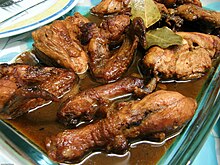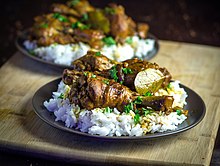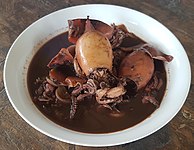Philippine adobo
 A serving of chicken-pork adobo | |
| Course | Main course |
|---|---|
| Place of origin | Philippines |
| Associated national cuisine | Filipino cuisine |
| Serving temperature | Hot |
| Main ingredients | Meat (beef, chicken, pork), seafood, or vegetables; soy sauce, vinegar, cooking oil, garlic, black peppercorn, bay leaf |
| Variations | Some sugar for sweet-salty taste. Adobo with no broth, only coating on the chicken. |
Food energy (per serving) | |
| Similar dishes | paksiw, kinilaw |
Philippine adobo (from Spanish adobar: "marinade," "sauce" or "seasoning" / English: /əˈdoʊboʊ/ Tagalog pronunciation: [ɐdobo]) is a popular Filipino dish and cooking process in Philippine cuisine that involves meat, seafood, or vegetables marinated in vinegar, soy sauce, garlic, bay leaves, and black peppercorns, which is browned in oil, and simmered in the marinade. It has occasionally been considered the unofficial national dish in the Philippines.[4][5]
History[]
The cooking method for the Philippine adobo is indigenous to the Philippines. Pre-colonial Filipinos often cooked or prepared their food with vinegar and salt to keep them fresh longer in the tropical climate of the Philippines. Vinegar, in particular, is one of the most important ingredients in Filipino cuisine, with four main traditional types: coconut vinegar, cane vinegar, nipa palm vinegar, and kaong palm vinegar, all of which are linked to traditional alcohol fermentation.[6][7][8]

There are four main traditional cooking methods using vinegar that are still widely prevalent in the Philippines today: kinilaw (raw seafood in vinegar and spices), paksiw (a broth of meat with vinegar and spices), (pre-cooking meat by braising them in vinegar and spices), and finally adobo (a stew of vinegar, garlic, salt/soy sauce, and other spices).[9][10][11][6] It is believed that paksiw, sangkutsa, and adobo were all derivations of kinilaw. They are also related to cooking techniques like sinigang and pinangat na isda that also have a sour broth, albeit using native fruits like calamansi, tamarind, unripe mangoes, bilimbi, santol, and star fruit instead of vinegar.[7]
When the Spanish Empire colonized the Philippines in the late 16th century and early 17th century, they encountered the adobo cooking process. It was first recorded in the dictionary Vocabulario de la lengua tagala (1613) compiled by the Spanish Franciscan missionary Pedro de San Buenaventura. He referred to it as adobo de los naturales ("adobo of the native peoples").[10][11][6]
The Spanish also applied the term adobo to any native dish that was marinated before consumption. In the 1794 edition of Vocabulario de la lengua tagala, it was applied to quilauìn (kinilaw) a related but different dish which also primarily uses vinegar.[12] In Vocabulario de la lengua Bisaya (1711), the term guinamus (verb form: gamus) was used to refer to any kind of marinades (adobo), from fish to pork. Other terms for precolonial adobo-like dishes among the Visayan peoples are dayok and danglusi. In modern Visayan, guinamos refers to an entirely different dish, bagoong.[13][14] Dishes prepared with vinegar, garlic, salt (later soy sauce), and other spices eventually came to be known solely as adobo, with the original term for the dish now lost to history.[15][16][8]
Description[]

While the adobo dish and cooking process in Filipino cuisine and the general description of adobo in Spanish cuisine share similar characteristics, they refer to different things with different cultural roots.[17] Unlike the Spanish and Latin American adobo, the main ingredients of Philippine adobo are ingredients native to Southeast Asia, namely vinegar (made from palm sap or sugarcane), soy sauce (originally salt), black peppercorns, and bay leaves (traditionally Cinnamomum tamala and related species; but in modern times, usually Laurus nobilis). It does not traditionally use chilis, paprika, oregano, or tomatoes. Its only similarity to Spanish and Latin American adobo is the primary use of vinegar and garlic. Philippine adobo has a characteristically salty and sour, and often sweet, taste, in contrast to Spanish and Mexican adobos which are spicier or infused with oregano.[11][18][19]

While the Philippine adobo can be considered adobo in the Spanish sense—a marinated dish—the Philippine usage is much more specific to a cooking process (rather than a specific recipe) and is not restricted to meat.[17] Typically, pork or chicken, or a combination of both, is slowly cooked in vinegar, crushed garlic, bay leaves, black peppercorns, and soy sauce. It is served with white rice.[10][20][21] It was traditionally cooked in small clay pots (palayok or kulon); but in modern times, metal pots or woks (kawali) are used instead.[22]
There are numerous variants of the adobo recipe in the Philippines.[15] The most basic ingredient of adobo is vinegar, which is usually coconut vinegar, rice vinegar, or cane vinegar (although sometimes white wine or cider vinegar can also be used). Almost every ingredient can be changed according to personal preference. Even people in the same household can cook adobo in significantly different ways.[17][21]

A rarer version without soy sauce is known as adobong puti ("white adobo"), which uses salt instead, to contrast it with adobong itim ("black adobo"), the more prevalent versions with soy sauce.[23][24] Adobong puti is often regarded as the closest to the original version of the Pre-Hispanic adobo.[17][25] It is similar to another dish known as pinatisan, where patis (fish sauce) is used instead of vinegar.[26]
Adobong dilaw ("yellow adobo"), which uses kalawag (turmeric) to provide the yellow colouring as well as adding in a different flavour, can be found in the Visayas and Mindanao regions.
The proportion (or even the presence) of ingredients like soy sauce, bay leaves, garlic, or black pepper can vary. The amount and thickness of the sauce also varies as some like their adobo dry while some like it saucy. Other ingredients can sometimes be used; like siling labuyo, bird's eye chili, jalapeño pepper, red bell pepper, olive oil, onions, brown sugar, potatoes, or pineapple. It may also be further browned in the oven, pan-fried, deep-fried, or even grilled to get crisped edges.[21][27]
Adobo has been called the quintessential Philippine stew, served with rice both at daily meals and at feasts.[20] It is commonly packed for Filipino mountaineers and travelers because it keeps well without refrigeration. Its relatively long shelf-life is due to one of its primary ingredients, vinegar, which inhibits the growth of bacteria.[10]
Variations[]

Based on the main ingredients, the most common adobo dishes are adobong manok, in which chicken is used, and adobong baboy, in which pork is used. Adobong baka (beef), along with adobong manok (chicken), is more popular among Muslim Filipinos.[28] Other meat sources may also be used, such as adobong pugò (quail), adobong itik (duck), adobong kambing (goat).[17] There are also seafood variants which can include fish (adobong isda), catfish (adobong hito), shrimp (adobong hipon), and squid or cuttlefish (adobong pusit). It can even be used to cook vegetables and fruits,[22] like water spinach (adobong kangkong), bamboo shoots (adobong labong), eggplant (adobong talong), banana flowers (adobong pusô ng saging), and okra (adobong okra).[29][30]
Even more exotic versions include adobong sawâ (snake),[31] adobong palakâ (frogs),[32] Kapampangan adobung kamaru (mole crickets),[17] and the adobong atay at balunbalunan (chicken liver and gizzard).[33]
There are also regional variations. In southern Luzon (Bicol region), and Muslim Zamboanga, for example, it is common to see adobo cooked with coconut milk (known as adobo sa gatâ). In Cavite, mashed pork liver is added. In Laguna, turmeric was added, giving the dish a distinct yellowish color (known as adobong dilaw, "yellow adobo").[10][21] In the northern province of Batanes, they prepare a kind of adobo called luñiz, which takes pork and preserves it in jars with salt.[34] In Batangas, adobo is cooked with achuete seeds, giving it a reddish color.[8]
Adobo has also become a favorite of Filipino-based fusion cuisine, with avant-garde cooks coming up with variants such as "Japanese-style" pork adobo.[35]
- Philippine adobo variants
Chicken adobo over rice

Adobo sa gata coconut milk

Pork adobo with pineapple

Adobong talong
(eggplant)
Adobung kamaru
(mole crickets)
Adobong kangkong
(water spinach)
Adobong hipon (shrimp)

Adobong pusit (squid)

Vegetarian adobo
Other uses[]
Outside of the dish itself, the flavor of adobo has been developed commercially and adapted to other foods. A number of local Philippine snack products such as cornicks, nuts, chips, noodle soups, and corn crackers, market their items as "adobo flavored".
In popular culture[]
In 2021, the Bureau of Philippine Standards of the Department of Trade and Industry (DTI-BPS) of the Philippines unveiled plans to standardize the most popular Filipino dishes to make it easier to promote them internationally as well as keep their cultural identity. Philippine adobo will be the first of such dishes to be standardized. The definition will be set by a technical committee headed by Glenda Rosales Barreto, and includes representatives from the academia, government departments, the food industry, chefs, and food writers. The main reference will be Kulinarya: A Guidebook to Philippine Cuisine (2008), authored by Barreto and the committee vice-chairperson Myrna Segismundo, both notable chefs of Filipino cuisine in their own right.[36][37] The announcement has received some criticism from the public, but the DTI-BPS clarified that it's not mandatory and will only aim to define a basic traditional recipe that can serve as a benchmark for determining the authenticity of Filipino dishes in the international setting.[38][39]
See also[]
- Humba
- Pata tim
- Paksiw
- Inihaw
- Dinuguan
- Cuisine of the Philippines
- List of Philippine dishes
- Kare-kare
References[]
- ^ "Calories in Filipino Pork Adobo - Calories and Nutrition Facts - MyFitnessPal.com". www.myfitnesspal.com.)
- ^ "Calories in Beef Adobo and Nutrition Facts".
- ^ "Calories in Chicken Adobo and Nutrition Facts". www.fatsecret.com.
- ^ DeWitt, Dave (2010). 1,001 Best Hot and Spicy Recipes. Agate Publishing. p. 428. ISBN 9781572841130.
- ^ Pangilinan, Jr., Leon (3 October 2014). "In Focus: 9 Facts You May Not Know About Philippine National Symbols". National Commission for Culture and the Arts. Retrieved 8 January 2019.
- ^ Jump up to: a b c Lim-Castillo, Pia (2006). "Traditional Philippine Vinegars and their Role in Shaping the Culinary Culture". In Hosking, Richard (ed.). Authenticity in the Kitchen. Proceedings of the Oxford Symposium on Food and Cookery 2005. Prospect Books. p. 296–298. ISBN 9781903018477.
- ^ Jump up to: a b Ponseca, Nicole; Trinidad, Miguel (2018). I Am a Filipino: And This Is How We Cook. Artisan Books. ISBN 9781579658823.
- ^ Jump up to: a b c Dacanay, Barbara Mae Naredo (1 May 2019). "There's nothing Spanish about adobo—should we ditch its Spanish name?". ANC X. Retrieved 10 March 2021.
- ^ "ADOBO: A History of the Country's National Dish". 14 July 2008.
- ^ Jump up to: a b c d e Rodell, Paul A. (2002). Culture and Customs of the Philippines. Culture and Customs of Asia. Westport, CT: Greenwood Publishing Group. p. 102. ISBN 9780313304156.
- ^ Jump up to: a b c Estrella, Serna (June 22, 2013). "Adobo: The History of A National Favorite". Pepper.ph. Retrieved March 21, 2016.
- ^ Domingo de los Santos (1794). Vocabulario de la lengua tagala, primera y segunda parte: en la primera, se pone primero el Castellano, y despues el Tagalo : y en la segunda al contrario, que son las rayzes simples con sus accentos. N.S. de Loreto. p. 42.
Adobo. Quilauìn. (pc) toman sàl vinagre, y chíle, y lo echan en la carne, pescado, ò tripas de venado; y asi medio crudo lo comen . . . Este mismo genero de adobo sirve para las yervas como ensalada.
- ^ Scott, William Henry (1990). "Sixteenth-Century Visayan Food and Farming". Philippine Quarterly of Culture and Society. 18 (4): 291–311. JSTOR 29792029.
- ^ R. P. Matheo Sanchez (1711). Vocabulario de la lengua Bisaya. Colegio de la Sagrada Compania de Jesus. p. 198.
Gamus. up. f Gamusun vel. gamsun. Salar o adobar carne, o pescado; ba cun gagamsun an isda sagan sin saguing, sin chile, sua. &c
- ^ Jump up to: a b Ocampo, Ambeth. (February 24, 2009). "Looking Back: 'Adobo' in many forms". Philippine Daily Inquirer. Archived from the original on May 23, 2015. Retrieved August 4, 2010.
- ^ Rappaport, Rachel (2010). The Everything Healthy Slow Cooker Cookbook. Adams Media. p. 255. ISBN 9781440508486.
Philippine Adobo variation.
- ^ Jump up to: a b c d e f Claude Tayag (March 8, 2012). "The adobo identity (crisis)". The Philippine Star. Retrieved November 7, 2012.
- ^ Zulu, Mijon (19 November 2017). "What Is the Difference Between Mexican and Filipino Adobo?". Chowhound. Retrieved 9 January 2019.
- ^ "This Chicken Adobo Is a Flavor Bomb of Salty-Sour Goodness". CookingLight. Retrieved 10 January 2019.
- ^ Jump up to: a b Alan Davidson & Tom Jaine. (2006). The Oxford Companion to Food. New York: Oxford University Press. p. 5. ISBN 0-19-280681-5.
- ^ Jump up to: a b c d Sifton, Sam. (January 5, 2011). The Cheat: The Adobo Experiment. The New York Times. Retrieved January 7, 2011
- ^ Jump up to: a b Kittler, Pamela Goyan & Sucher, Kathryn (2007). The Culinary culture of the Philippines. Cengage Learning. p. 371. ISBN 9780495115410.
- ^ Artie Sy (August 11, 2011). "The Admirable Adobo". Sun Star. Archived from the original on August 14, 2011. Retrieved November 7, 2012.
- ^ "Adobong Puti (White Chicken Adobo) for Kulinarya Cooking Club". FoodPress. June 19, 2011. Retrieved November 7, 2012.
- ^ "The BEST Pork Adobo a la Marketman". Market Manila. May 7, 2008. Retrieved November 7, 2012.
- ^ "Adobong Puti (White Adobo)". AdobongBlog. October 4, 2011. Retrieved November 7, 2012.
- ^ Cordero-Fernando, Gilda (1976). The Culinary culture of the Philippines. Bancom Audiovision Corp. pp. 11–13.
- ^ Jeroen Hellingman (March 28, 2003). "Adobong Baka (Beef)". Bohol.ph. Retrieved November 7, 2012.
- ^ Alejandro, Reynaldo G. (1985). The Philippine Cookbook. Penguin. pp. 52–60. ISBN 9780399511448.
- ^ AdoboChef (January 5, 2011). Traditional Adobo Recipes Archived 2012-06-18 at the Wayback Machine Retrieved June 22, 2012
- ^ "Only for the Daring: Exotic Food Finds in Cebu". Cebutourist. June 17, 2011. Archived from the original on January 19, 2013. Retrieved November 7, 2012.
- ^ "Adobong Palaka". San Pablo City. October 14, 2010. Archived from the original on April 16, 2013. Retrieved November 7, 2012.
- ^ "Adobong Atay at Balunbalunan (Chicken Liver and Gizzard)". Reel and Grill. December 9, 2010.
- ^ Javellana, Abigail (2017-04-24). "IVATAN CUISINE: The Flavors of the Batanes Isles! • Awesome!". Awesome!. Retrieved 2020-12-09.
- ^ Manipon, Roel Hoang (2016-02-01). "Japanese-style adobo and other delicious things you can cook in a microwave oven". The Daily Tribune. Archived from the original on 2016-02-01. Retrieved 2018-03-23.
- ^ "Standardization of famous Filipino dishes advances!". Department of Trade and Industry. July 9, 2021.
- ^ Canivel, Roy Stephen C. (July 10, 2021). "Committee to decide what is 'standard' adobo". Philippine Daily Inquirer.
- ^ Ramos, Christia Marie (12 July 2021). "DTI says standardizing Philippine adobo only for international promotion". Philippine Daily Inquirer. Retrieved 13 July 2021.
- ^ Punzalan, Jamaine (12 July 2021). "Standard adobo, sinigang, sisig? DTI says aiming for international promotion". ABS-CBN News. Retrieved 13 July 2021.
External links[]
 Media related to Adobo (Filipino cuisine) at Wikimedia Commons
Media related to Adobo (Filipino cuisine) at Wikimedia Commons Adobo at Wikibook Cookbooks
Adobo at Wikibook Cookbooks
- Philippine cuisine
- National dishes










